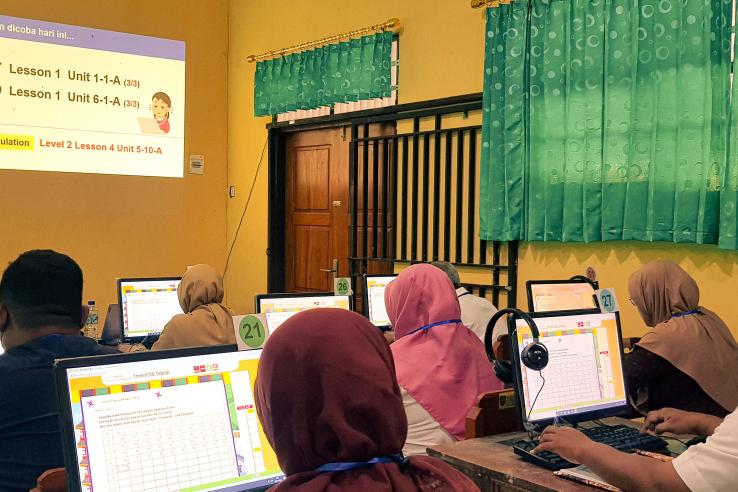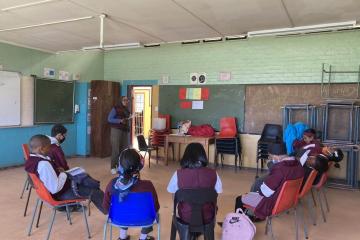
Integrating tech in post-pandemic classrooms: Insights from teachers

Guru SMP Negeri menghadiri pelatihan penggunaan platform teknologi pendidikan (ed tech) di Jawa Tengah, Indonesia. Foto: Miranda Aisha Putri (J-PAL SEA).
The Covid-19 pandemic permanently transformed public schools in Indonesia. Almost overnight, online classrooms replaced in-person teacher-student interactions, accelerating the integration of technology into education. Public school teachers have been among the most impacted, needing to adjust to the changes while ensuring students are engaged and learning.
As part of our work in the education sector, J-PAL Southeast Asia (J-PAL SEA) initiated a study with J-PAL affiliated professors and coauthors to evaluate the impact of a teaching method that integrates technology and interactive student-centered teaching to improve students’ math outcomes. As part of the study, the J-PAL SEA team visited several public junior high schools in Jakarta and Central Java, where they had the opportunity to learn from public school teachers about their experience teaching in a post-pandemic setting. From these conversations, the J-PAL SEA team gained insights that we believe are beneficial in understanding more about the opportunities and challenges of integrating technology into schools in low- and middle-income countries. This blog discusses a few of those key learnings.
1. Technology has the potential to make teaching and learning more engaging and interactive
Teachers shared that the accelerated integration of technology provided them the opportunity to improve their teaching skills and learn new ways to create a more engaging classroom. For example, several teachers shared that they use the Indonesian government’s Platform Merdeka Mengajar, a web- and app-based teacher capacity building platform, to access new teaching materials (e.g. videos, sample problem sets, and visual aids) that can help them implement Indonesia’s new curriculum (Kurikulum Merdeka) and introduce variation to classroom activities. They also mentioned the use of several local educational technology (also referred to as ed tech) and social media platforms to learn different classroom management methods from content shared by fellow teachers and educators. Finally, teachers reported benefiting from continuously learning from students about ways to make learning more engaging and relevant to the students’ interests.
2. Gamification can be used to ease student learning challenges
As students return to in-person learning, teachers expressed additional challenges in ensuring an enjoyable and meaningful learning experience. Many students in Indonesia are returning to school with evident learning challenges due to learning loss. These are compounded by being scared or anxious about learning subjects that they perceive as ‘difficult,’ such as mathematics, which can lead students to feel unmotivated or struggling to maintain focus to learn. In these cases, ed tech may be instrumental. For example, teachers shared that they try to vary their teaching methods by using online softwares, such as Kahoot! and Quizzis, to gamify learning. They also create visually appealing lecture decks using Canva or similar platforms to further engage students in learning all subjects, including those deemed as ‘difficult’. Integrating ed tech into learning activities also motivates students and teachers to improve their tech skills, which, when supported with adequate additional training, can also be transferable outside of the classroom.
3. Availability and accessibility of short-form content on social media may impact students’ attention span and ability to focus in classrooms
Integrating technology into today’s classrooms opens many doors for improvement, creativity, and innovation. However, teachers also expressed their concerns about embracing this accelerated change, especially since technology is becoming increasingly integrated in our everyday lives. As students return to in-person learning, teachers have observed a decline in attention spans and ability to focus. Additionally, as more online content (i.e. on websites and social media platforms) becomes simplified, teachers have a harder time keeping students engaged in class. This may be because students are used to consuming quick information. For example, a few teachers shared that some students show reluctance in solving complex mathematics exercises such as narrative problem sets, preferring to have the answers readily provided. Teachers are exploring possible gadget-use policies in class to ensure that devices are used for educational purposes. This endeavor requires teamwork and trust between the schools, teachers, and students—a relationship they are constantly rebuilding and honing to adjust back to learning in-person. Addressing these challenges will require further considerations and insights, so schools can find the most effective ways to integrate technology into learning.
Way forward
Technology provides opportunities for teachers to enhance teaching and learning for students. However, from these conversations, we also learn that integrating technology into post-pandemic classrooms also requires further support. For example, teachers need additional dedicated training to equip them with the technical skills to translate tech-driven innovation into meaningful learning. Furthermore, since schools in the archipelago have unequal access to resources like stable internet, hardware, and trained school personnel, policymakers must be proactive in addressing the challenges that may arise when integrating technology into education to prevent any further widening of educational disparities.To address these questions, J-PAL affiliated researchers are conducting research that could bring more insights on the integration of technology in education in Indonesia.
Stay informed about our latest research by visiting our website, following us on Twitter, or connecting with us on LinkedIn.
Related Content

A decade of empowering change: Celebrating 10 years of improving lives through evidence in Southeast Asia

Understanding the hidden factors influencing child marriage: Lessons from an impact evaluation

